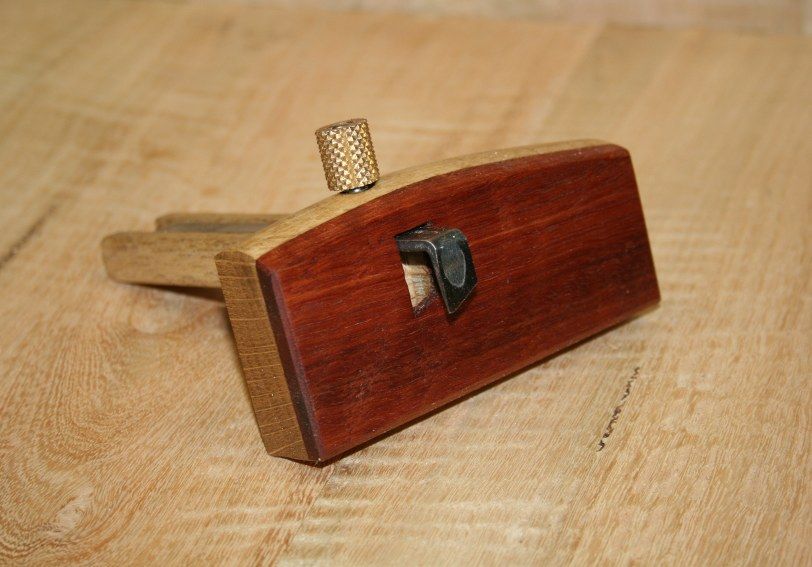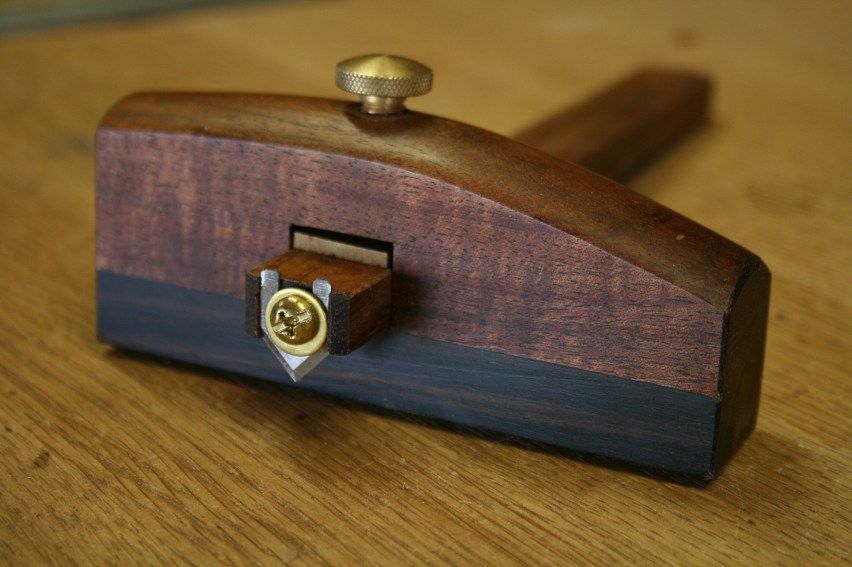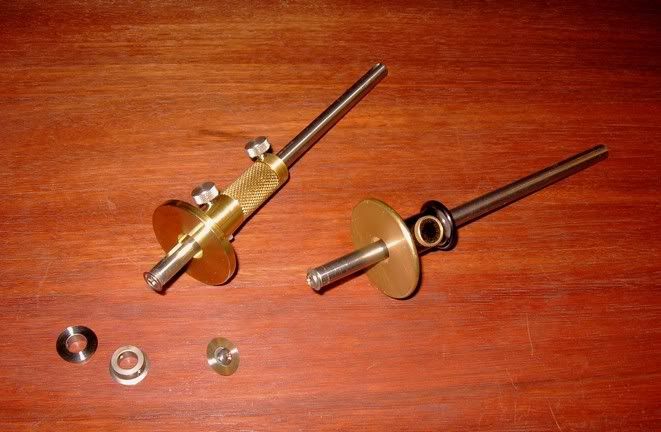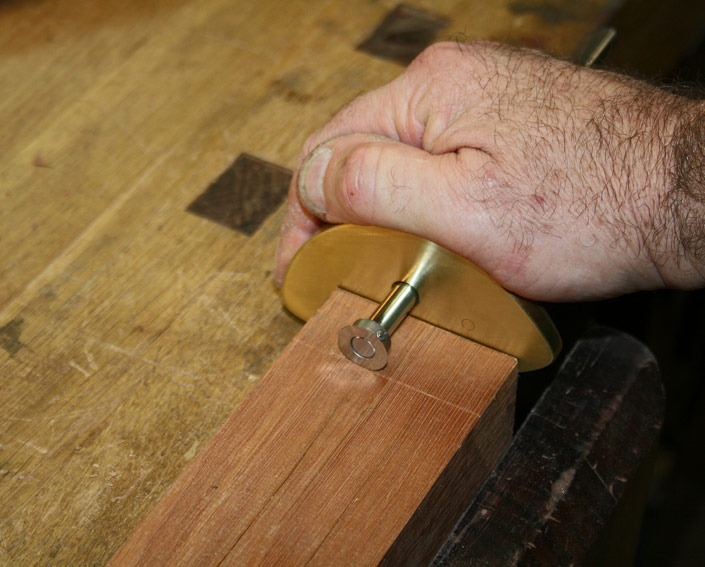 Needs Pictures: 0
Needs Pictures: 0
 Picture(s) thanks: 0
Picture(s) thanks: 0
Results 1 to 15 of 26
Thread: Marking gauge suggestions
-
13th January 2015, 09:06 AM #1
 Novice
Novice











- Join Date
- Jul 2014
- Location
- USA
- Posts
- 13
 Marking gauge suggestions
Marking gauge suggestions
I'm looking for a general purpose marking gauge. There seem to be lots of options. In addition to any suggestions about your favorite brand or design, I'm particularly interested 2 questions: the wheel style vs. the more traditional type of gauge; and how necessary is a double bevel on the blade? I'm left-handed if that matters.
Thanks
-
13th January 2015 09:06 AM # ADSGoogle Adsense Advertisement
- Join Date
- Always
- Location
- Advertising world
- Posts
- Many
-
13th January 2015, 05:48 PM #2
 SENIOR MEMBER
SENIOR MEMBER











- Join Date
- Mar 2009
- Location
- Sydney
- Posts
- 651

I currently have 5 different marking/cutting gauges. 2 cutting gauges, 1 marking gauge ( made by Ian Wilkie, bought on this forum). 1 Veritas wheel gauge and 1 carbatec mortise gauge.
The first gauge I got was the carbatec mortise gauge, and although it done the job I found that it could be hard to get consistent straight lines, would often catch and follow the grain. This does have a lot to do with my incompetence.
Because of this I was very happy when I got the marking wheel, is very easy to use and the easiest to fine adjust.
But my favourite by far are the 2 cutting gauges. These are just lovely to use. The marking gauge came as a pair with one of the cutting gauges, and although it is very nice I don't use it a lot.
So when it comes to marking out now my go to tools are the marking gauges, and yes gauges, I nearly always use both of them set at different depths and try leave them there until I'm sure I won't need that setting anymore.
But if I am working on smaller pieces then the marking wheel is a lot easier to use. It just seems to be slightly easier to control.
But that's just one right handed opinion..
cheers.
-
13th January 2015, 07:00 PM #3
 GOLD MEMBER
GOLD MEMBER











- Join Date
- May 2011
- Location
- Albury
- Posts
- 3,034

I have found the Japanese ones like this http://www.traditionalwoodworker.com...6-12762-lg.jpg good. Nice long fence, can be sharpened, can mark out mortices as well, easy to use and cheap.

-
14th January 2015, 12:05 PM #4

Originally I picked up a marking gauge with the sharp point on the end, it is in pristine condition. The one that I use the most is the Veritas wheel marking gauge. The wheel will need to be sharpen every now and then. A very light touch on some fine sand paper is all I do.
-
14th January 2015, 08:16 PM #5

OK, so I like my tools to be reasonably handsome, but you know, a nail driven through a stick with some kind of rough stop attached, can do the job! However, that's a bit crude, and not so easy to adjust, so the first essentials you want in a gauge are that it has a stock that is square to the beam (or close), and the beam locks firmly where you set it. I prefer the locking thumbscrew on top, out of the way (which also suits both right & left handers equally), but others prefer them on the side. Another property to look for in a gauge is that it slides smoothly when the locking mechanism is loosened just a touch. That indicates the beam is straight & accurately dimensioned, and makes the gauge easy to set.
Now, cutting point, needle point, or wheel, - which is best? My answer would be, 'none of the above'. They all have their place(s). I prefer needle points for marking along the grain, cutting points across grain. Needle points are good for marking a 'stop' point, e.g., when marking out a hinge recess, or anywhere where you want a line to stop precisely. Lots of folks like wheel markers, but I don't get on with them at all. That's probably a character defect & not the fault of wheel markers.. It's mostly because my chronologically challenged eyes need a decent line to see it clearly, so I like bold marks. Good clear lines are also handy to register chisels in, when edges need to be trimmed to precise dimensions. Wheel markers often leave pretty light marks (a good thing, of course when you want light marks). I very rarely have a problem with a needle point 'following grain' - if that happens, you need to work on your technique!
It's mostly because my chronologically challenged eyes need a decent line to see it clearly, so I like bold marks. Good clear lines are also handy to register chisels in, when edges need to be trimmed to precise dimensions. Wheel markers often leave pretty light marks (a good thing, of course when you want light marks). I very rarely have a problem with a needle point 'following grain' - if that happens, you need to work on your technique!
My advice would be to go & buy a couple of inexpensive gauges and use them for a while to see what you do & don't like about them, then lash out on some 'nice' gauges later, if you feel the need. You'll always find a use for the cheapies - it's good to have several gauges on hand when doing complex joinery.
Mortise gauges are far from essential, but they are very handy things to have. I use mine a lot. They seem to take a bit of getting used-to, I've noticed a lot of people struggle with them at first. To use any gauge, let the point or cutter trail away from the direction you're moving in, and rotate the gauge to apply enough pressure to get the points or cutters to mark, as you apply pressure to the stock to keep it registered against the edge you're marking from.
One last gauge not mentioned, but which I find enormously useful, is a pencil gauge: Blackwood pencil gauge.jpg
There are many occasions where I want to mark a line for some reason, but I don't want it to be permanent - a pencil gauge is the bees' knees in that situation...
Cheers,IW
-
14th January 2015, 08:23 PM #6

Another point to consider is replacement cutting tips. Should yours have n accident or wear out how easy is it to replace? Pin tips can easily be made from an old drill bit, cutters depending on the design old stanley knife blades. Wheels have to be bought and I believe they are not all equal so you need to buy from the original manufacturer.
Does anyone have a supplier of cheap wheels, if so you could make your own.…..Live a Quiet Life & Work with your Hands
-
15th January 2015, 05:12 AM #7

I have a fair number of different styles and makes of marking gauges but the hands down winners in my experience are those made by Bridge City Toolworks. I haven't used any other high end gauges but compared to the kind of gauges sold at woodworking stores or older Stanley gauges BCTW gauges are miles ahead and I consider them well worth the money they command.
Innovations are those useful things that, by dint of chance, manage to survive the stupidity and destructive tendencies inherent in human nature.
-
15th January 2015, 01:16 PM #8
 Novice
Novice











- Join Date
- Jul 2014
- Location
- USA
- Posts
- 13

Thanks for all the good advice. I think I'll start with a cheap wheel gauge I saw at Woodcraft (from which I have a gift card). And then I'll go from there as needed.
-
3rd March 2015, 12:50 PM #9
 Member
Member











- Join Date
- Feb 2014
- Location
- Sydney
- Posts
- 70

Can i just asks a few more questions on this topic?
I have a 3 in 1 marking gauge from Carbatec. I can say that i really don't like the blade - it is probably me - but i find it really follows the grain and also the line closes up pretty much straight away and i can't see it.
I find the pin OK - but hard to use as it seems I have to tilt the gauge a fair bit in order to get a good registration on the fence - and then i find it doesn't mark that well as a result.
I do really like the wheel - especially for cross grain marking. For long grain marking i do find it also follows the grain a bit. It is now also getting dull i think
Most of the marking i have done so far is on either pine or Vic Ash.
So my questions are:
** How do you sharpen the wheel (i saw suggestions of sandpaper above)? I have tried running it along the edge of a super fine diamond stone by hand at what i hope is the right angle, then i flipped it a tried to flatten the top to remove any bur. Not sure how successful this was. Any other techniques?
** What technique should be used for long grain marking to help avoid it following the grain. I noticed that Ian says he uses the a pin for long grain - is that the best/only solution?
Sorry if theses are dumb questions.
Thanks in Advanced
-
3rd March 2015, 03:16 PM #10

When I sharpen the wheel of the gauge and after dismantling it, I place it on wet and dry sand paper. The sand paper is on a flat piece of glass, but I have also used a short piece of MDF that I will dispose afterwards. Add some water to the paper and place the wheel flat on the wet and dry. Couple of strokes to clean up the face and that's it. I don't do anything to the bevel.
I use the same wheel gauge for the long grain just making sure that I have my thumb pressing on the barrel and hard against the edge. I can not tell you how much pressure but for me it does not slip or follow the grain.
The wet and dry sand paper is either 320 or 400 grit. But I have also used 240 when I could not locate one of the other two. You are not taking off a lot of metal only just touching it up.
-
3rd March 2015, 08:01 PM #11

Like so many tools, Marphlix, there are several ways to use a gauge, and they can all work, with a bit of persistence.
I know there are many as disagree, but I see no point in using a cutting or wheel gauge along the grain for marking out. I will use cutting gauges along the grain when I want to make a deep cut, as in marking out a hinge rebate, otherwise they are for cross-grain marking, in my view. Pins can make a right mess if used heavy-handed across the grain! As you have noticed, wheels & cutters don't leave a very distinct mark, and have a tendency to wander in strong-grained woods when used along the grain. This can be minimised, though not entirely eliminated in all woods, by setting the bevel, either of wheel or cutter facing the fence, so that it tends to pull the gauge away from the edge of the work, & help keep the fence registered.
Since the object of the exercise is to make a mark that you can see, you may as well use something that does that. For the average eye, the limit of resolution at a normal working distance is 0.2mm, so there is no point in making a mark any finer than that. I use slightly blunt points on my pins, so that they make a distinct mark - I need all the help I can get at my age!
To minimise wandering, try concentrating your effort on keeping the fence registered against the edge of the work. Roll the gauge into the direction of travel, as you mention, then press back a little on the cutter or pin; just enough to make a visible mark. If the cutting edge or pin is trailing the direction of travel, there should be little tendency to wander, as long as you keep that fence registered firmly. At first you will have to think about it, but it will soon become second nature, & you'll wonder why you had any trouble in the beginning.....
Cheers,IW
-
3rd March 2015, 09:09 PM #12

My turn

Whether one uses a pin, a wheel, or a cutting blade, the correct way to score a line is in multiple strokes, never one deep line. Begin with barely stroking the surface, just enough to sever the fibres. Then do it again increasing downforce and cutting a little deeper. This is still a fine line. Finally, score deeper still. This applies with all types of gauges.
Rule #2: Knives are better across the grain. Pins are poor in this regard. Regrind all pins to a knife. Pins are OK with the grain, but so can a knife be. In fact, I prefer a knife along the grain to a pin. It is the wheel along the grain that leaves a fainter line, because it is so fine. This can be remedied with multiple cuts.
A modified pin looks like this ...

One of the advantages of a knife cutter is that it creates a line with one side perpendicular (and the other angled). We always want to be working with a straight, perpendicular line, such as when forming a knife wall for tenon shoulders or chopping to a dovetail baseline. The wheel cutter and pin do not do this.
WW123, being left-handed is an issue, since the best gauges are Japanese, which use knives, and all the ones I've seen are designed for a right-hander (the direction of the hand grip and the cutters).
Here's an example of one I made for myself to illustrate ...

Here is a similar style, another I made, with a cutting blade that may be used either to the left- or right ...

Hamilton tools make one similar ...
The Veritas wheel gauge is excellent value for money, and you get superb backup service. More expensive, and with a little more class (but no more functionality) is the Tite-Mark ..

Regards from Perth
DerekVisit www.inthewoodshop.com for tutorials on constructing handtools, handtool reviews, and my trials and tribulations with furniture builds.
-
3rd March 2015, 10:30 PM #13

Interesting, Derek - I guess Japanese woodworkers like to pull their marking gauges towards them, whereas I come from the 'push-away' school. That Japanese gauge would be a leftie, in my view.
Now this is a good example of convergent evolution.
I make my cutters by grinding a cutting face on a 3.2mm pin. The cutter is shaped so that it will cut equally well in either direction. I always orient the cutter so that the bevelled face is towards the fence, as you've done on this one, because when moving through the wood, this will tend to pull the cutter away from the fence, helping to keep it registered. Also, it is more often the edge furthest from the fence that you want to be perpendicular, although I don't think that this is a big issue, given the width & depth of an average layout line! One advantage of my gauges is that you can orient the pin any way you like, by simply loosening the grub screw & twisting it to your desired position: RG cut.jpg
So to me, this cutter seems to be attached 'back to front': Cheers,IW
-
3rd March 2015, 11:15 PM #14

Hi Ian
That last gauge's blade is reversed as it is dedicated to slicing inlay.
Here is another example of the direction for the bevel of a knife. On this mortice gauge, the bevel will leave a "v" in the waste, while the outer side of the line is perpendicular ...


One can get away with the bevel being reversed when the blade is so thin and cut such a fine line ...


You know, between us we have turned out just about every possible gauge design imaginable!
Regards from Perth
DerekVisit www.inthewoodshop.com for tutorials on constructing handtools, handtool reviews, and my trials and tribulations with furniture builds.
-
3rd March 2015, 11:42 PM #15
 GOLD MEMBER
GOLD MEMBER

- Join Date
- Jun 2014
- Location
- Seattle, Washington, USA
- Posts
- 1,857

Sorry I'm not going to read the previous responses so I apologize for redundant statements.
I use an all metal marking gauge. The Veritas Dual Marking Gauge.
I like it because you have so many options. I would get on their website and check out the manual and you will be impressed by its versatility. There are two cutters which are oriented in opposite directions so you can always have the bevel facing the right way.
Can't comment on wheel vs pin style, but wheel seems fundamentally better to me.
Similar Threads
-
Marking Gauge Vs Cutting Gauge
By GraemeCook in forum HAND TOOLS - UNPOWEREDReplies: 10Last Post: 11th July 2014, 01:10 AM -
Cutting Gauge or Marking Gauge ???
By GraemeCook in forum HAND TOOLS - UNPOWEREDReplies: 34Last Post: 4th July 2013, 09:07 AM -
Which marking gauge?
By SimonArchibald in forum HAND TOOLS - UNPOWEREDReplies: 27Last Post: 30th June 2013, 08:30 PM -
Marking Gauge
By RedShirtGuy in forum HOMEMADE TOOLS AND JIGS ETC.Replies: 6Last Post: 28th July 2012, 09:48 PM -
Old marking gauge
By mañana in forum ANTIQUE AND COLLECTABLE TOOLSReplies: 13Last Post: 14th December 2008, 03:05 PM



 Thanks:
Thanks:  Likes:
Likes: 
 Reply With Quote
Reply With Quote




